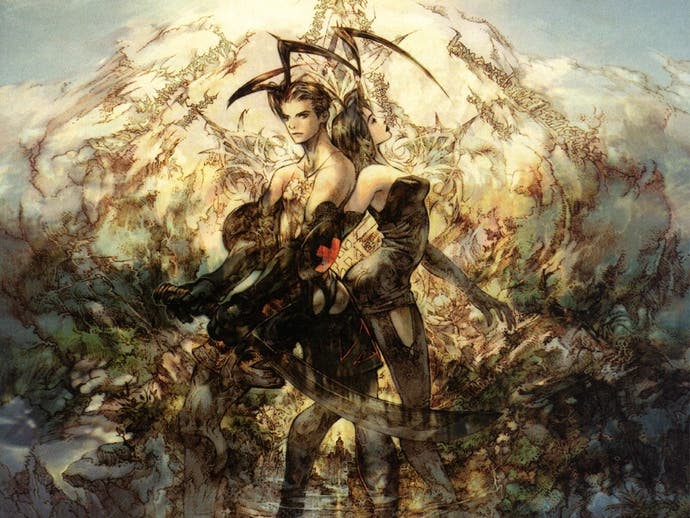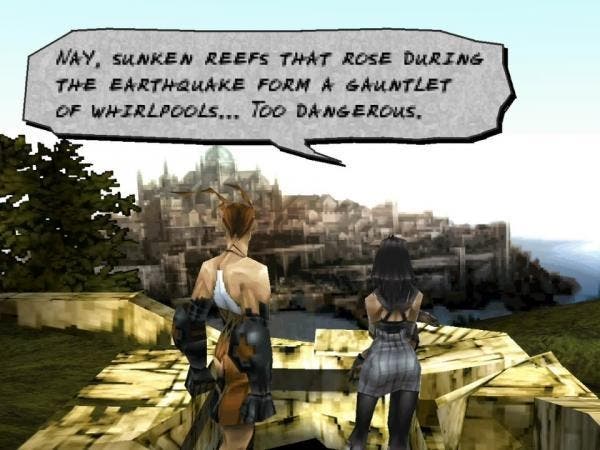Vagrant Story Retrospective
I predict a Riot.
When Sydney Losstarot summons the devil, the devil comes a-sprinting - or, at the very least, sends his most senior fiends without delay. We players are used to occultish showmanship: the sweep of the staff, the hooded head bowed in dramatic concentration, the twitch-lipped incantation; the purplish burst of colour as spell conjures from air. It's grown routine, robbed of spectacle by familiarity. So we thumb-twiddle till the cutscene plays itself out. Get on with it.
But when Sydney Losstarot casts a spell everything's different. He kneels, glaring at existence through his blonde fringe, a scissorhand nail scratching arcane symbols on a bald cobblestone. Then to his feet and, in loud proclamation, issues reminders to the darkness of the terrible oaths they've made, of 'sin-soaked contracts of kinship' and other such unsettling imagery. It's not a plea for devilish help; it's a demand. God help the imp who doesn't show. God help us all. It sends shivers down your spine, moments before those shivers turn to shockwaves as a summoned golem brings down his gravel hammer.

Sydney Losstarot. The cult prophet's surname is a prickly contraction that speaks of defeat on the cards. Sydney Losstarot. The tattoo on his back - always on display and, in the game's most gruesome twist, the unholy grail that some wish to carve from him for themselves - is a brand bespeaking his fragile hell-contract for immortality. When Sydney Losstarot summons the devil, you better look lively.
In Squaresoft's peculiar police line-up of arch-villains it's Final Fantasy 7's Sephiroth who is most regularly called forward to mind. But Losstarot is the developer's most mesmerizingly wicked creation - and he's not even the primary antagonist in his game.
Vagrant Story, one of the final releases for Sony's PlayStation and designed by Yasumi Matsuno and his crack team of number-crunching tacticians, is a game riddled in medieval intrigue, warring factions, grimoires and knife-in-the-dark power wrangling. But beneath the bluster it's a game about men locked in an irresistible duel. Sydney Losstarot, and you, the hero: Ashley Riot.
Ashley Riot, by contrast, ill-fits his name. His dour demeanour - a coolness derived from years of dehumanising military focus - ensures there's no riot of laughter when he settles into a scene. His preference to work alone - a shadow assassin who's as comfortable wielding a crossbow as a lance - sees him part company with his companion Callo Merlose at the entrance to the game's story. He is a one-man army - alone for almost the entire game, save for a brief moment when he and Losstarot join forces.
There's no thronging riot of sword-flash here: just precision murder, caring strikes to lay enemies low: leg then arm then torso.

This sense of martial calculation is hardcoded into Vagrant Story's divisive, intricate combat system, which freezes the game before every strike, allowing you to pick out the specific part of the enemy's body you wish Ashley to target, or to swap your weapon for one more tailored to their type. It requires a different mode of thinking, an altered rhythm of thought. In video games we are used to picking the most powerful sword and, when we find a better one, discarding the former. Here, weapons are tools, not linear statistical upgrades, and you must pick the right tool for the right job.
Nothing is wasted. Should your crossbow be superseded by a new find in some cobwebbed chest, you may dismantle it and use the constituent parts to create a new item. The flexibility is dizzying because it comes with the tight squeeze of responsibility. Find yourself ill equipped for a particular fight and you have none to blame but yourself.
This planning and pause for strategizing is contrasted by the rhythm action style attacks themselves, which allow you to combo additional swipes with well-timed button presses, near indefinitely. Different weapons have different rhythms, the only indication of what-to-do-and-when coming from an exclamatory pop-up '!' to say: 'Now! Hit the button now!' After the room is cleared you may be presented with one of the game's innumerable crate puzzles, that usual indicator of the idea-starved game designer, but here both relevant, appropriate and, very often, ingenious as you stack boxes of different materials to create leg-ups to new rooms and adventure.
Ashley's is a quiet riot then, spinning contained, methodical through the labyrinthine dungeon under the hilltop town Lea Monde in which the game takes place. Up and up it goes till it spills onto its cobbled streets and, finally, pierces its heart of darkness, the cathedral standing at its centre, full of tall pride and Catholic secret.
A simple story accompanying a simple journey, then, but one told in Shakespearean cadence (after all, this is a game in which Hamlet namesakes Rosencrantz and Guildenstern assume primary roles) and, through some expert direction, elevated from the usual pantomime of video game cutscene acting to something altogether more assured. The strength of the camera composition cannot be overstated, putting so many contemporary games to shame with its restless pans and dramatic skews. The script, colourfully translated by Alexander O. Smith, may be overegged in places, but the animation and acting has an authenticity that makes every monologue palatable, every flickering PlayStation polygon unexpectedly heavy and true.

As with the best games, the setting plays a primary role. The trudge through the opening dungeons may feel long and arduous, all dank identikit walls echoing with the whisper and scurry of subterranean life. Break into the melancholy sunshine of Lea Monde's French small town ambiance, though, and the sense of place is reassuringly grounding. It's a sad beauty though, the light revealing cracks of a community brought together by some unspeakable communal secret; fractures in the stonework, fissures in the smile.
For this reason there's a cloying, heavy atmosphere to the game. There's no comic relief and necessarily fussy menus, which have you diving in and out of sub-screens far too often for most players to stomach, compound the overbearing atmosphere. The decision to make weapons and equipment level up and develop, rather than Ashley himself demands care and attention over your inventory, the repairing, reworking, renaming certainly adding a personal twist to the journey, but at the cost of some arduous menu-hopping.
Despite Matsuno's eye for detail and the heavy sense of intention behind every design decision, it's a messy game too, the narrative interludes towards the end of the game becoming more and more spaced out, some systems never quite coming into full bloom. By the time of the game's release in 2000, the PlayStation was busy making its deathbed. Perhaps this was the reason that Squaresoft rushed this game's completion, cutting - according to Matsuno - almost half of the game's story and features in order to hit release date. It's surprising then that Vagrant Story manages to be quite so cohesive.
A daring, ambitious trek then, one that woos the susceptive mind with its riddle and consequence while confounding the impatient. And more than this, proof of what a talented team can uncover when allowed off the leash, given a chance to create away from the shackles of iteration and influence; to create rather than, Losstarot-style, re-conjure.


